Bright and juicy fruits of tomatoes are appreciated for their pleasant taste and vitamin composition. Proper planting and care of tomatoes in the open ground will require compliance with a number of agrotechnical rules. To obtain a quality crop, it is important to use seeds of zoned varieties, to grow strong seedlings and to create optimal conditions for abundant fruiting.
Material Content:
Selection of tomato seeds for open ground
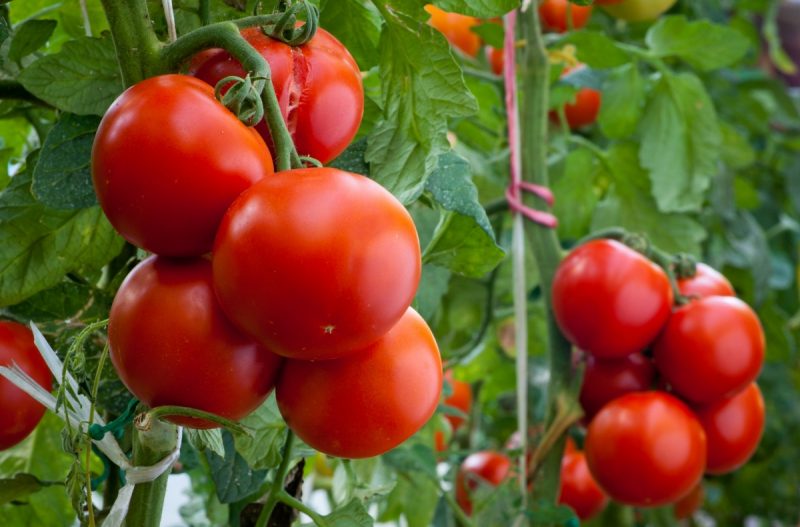
When selecting varieties, the climatic characteristics of the region, soil quality and the location of the site must be taken into account. Also pay attention to the nature of the growth of tomato bushes: whether the formation, installation of trellis and garter will be required.
Development features
There are indeterminate and determinant varieties of tomatoes. The former are characterized by unlimited growth, bloom and set fruit from summer to autumn; reach a height of 2 m or more. In the south they manage to ripen in the open ground, but in the northern regions they create problems.

The height of determinant tomatoes is from 40 to 80 cm. Tomatoes of this group are grown in open ground in the south and in the middle lane, cultivated in greenhouses to the north. After the formation of the last flower brush, the shoot no longer grows in height. Harvest ripens in a relatively short time.
Ripening time
In the southern regions grow tomatoes early, medium and late ripening. In the north, early hybrids are preferred.Typically, early tomatoes have red, medium-sized fruits. Among late varieties, a wide variety of shapes and colors: round, elongated, pink, yellow and almost black berries.
Varieties and hybrids of tomatoes for open ground:
- Early ripe: Moscow Region F1, Northern Miracle, New Transnistria (determinant).
- Mid-season: Appetizing, Bull's heart, Pioneer, Monomakh hat (determinant).
- Late ripe: St. Andrew's surprise, De Barao (indeterminate).
Attention! Hybrid tomatoes usually produce high quality early crops, but are more demanding on growing conditions. Bushes grow from the seeds of such tomatoes, which differ from the hybrid for the worse.
When choosing seed, it is also necessary to consider the suitability of the region. If the varieties of tomatoes are non-zoned, then they will not show their best qualities, designed for cultivation in a particular climate.
Growing seedlings for planting in open ground
This method is optimal for obtaining a tomato crop in a short time, for cultivating plants in the northern regions.
Sowing Tomato Seeds
Use plastic containers filled with nutrient soil with a diameter of 8-10 cm. The choice is wide enough: round and square seedling pots, special cassettes, plastic glasses.
How to sow:
- The soil mixture is poured with warm water with dissolved universal fertilizer for vegetables (1 tbsp. Per 10 liters of water).
- Two shallow pits (1 cm) are made in the center.
- Lay one seed at the bottom.
- Sprinkle the seeds with soil.
In the south, sowing seeds for seedlings is carried out in February, in the middle lane - from early March to the end of the month.
Seedlings
Individual seedlings or pots after sowing are placed in a box installed in a warm place (at least 22 ° C). After a week or earlier, sprouts begin to hatch. The box is rearranged in a well-lit place, for example, on the windowsill, but not from the north side.
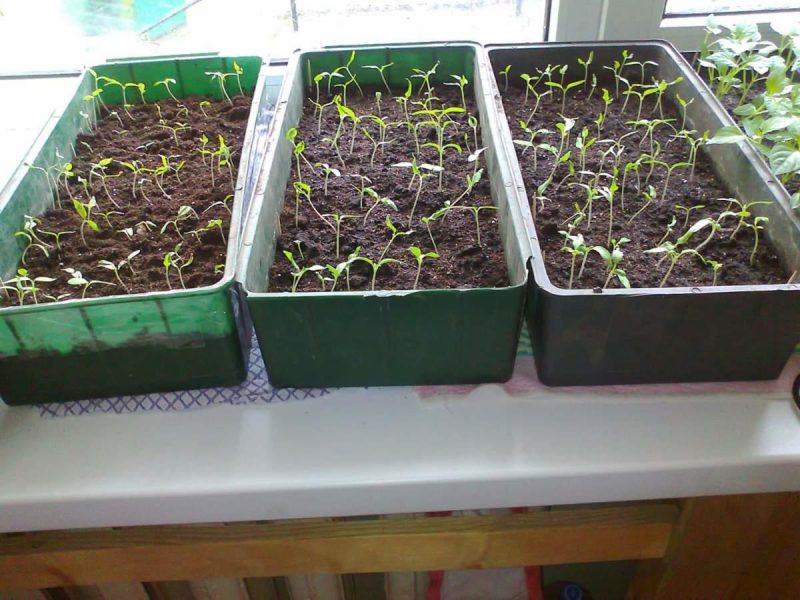
Tip. If both seeds germinate, then leave a larger and more even seedling. Healthy stocky seedlings with 7-10 leaves better take root on the site.
So that the seedlings do not stretch, they need a temperature of no higher than 16 ° С during the day, and about 14 ° С at night. The optimum temperature regime for the formation of leaves is 18–20 ° С.
Proper care of young plants before planting in open ground
Seedlings are regularly watered and fed three times for 50-60 days. The first time a complex fertilizer is used - nitrophoska (nitrate nitrogen, phosphorus and potassium). The second time a mixture of organic and mineral fertilizers is used. For the third top dressing, a superphosphate solution is prepared in advance (2 tbsp. Per 10 liters of water). After a week, you can plant tomatoes in open ground.
Seedling hardening
Young plants become stronger and less extended in length as a result of exposure to low temperatures. Hardened seedlings in April to prepare for planting in open ground in May. During the day, open a window for a short while or take out boxes on the balcony and terrace. The temperature for such air baths should not be lower than 10–12 ° С.
Plants are gradually getting used to outdoor conditions and direct sunlight. In the early days, it is recommended to shade seedlings. Do not overmoisten the soil in pots or leave it dry.
It is interesting:open cabbage
The choice of purchased seedlings
Acquisition in nurseries or self-cultivation? The answer is most obvious for those who do not have enough time to sow in pots, temper plants. In addition, when buying seedlings, it is possible to purchase plants of various varieties and ripening dates. Growing and labeling a large number of seedlings at home is a troublesome task.
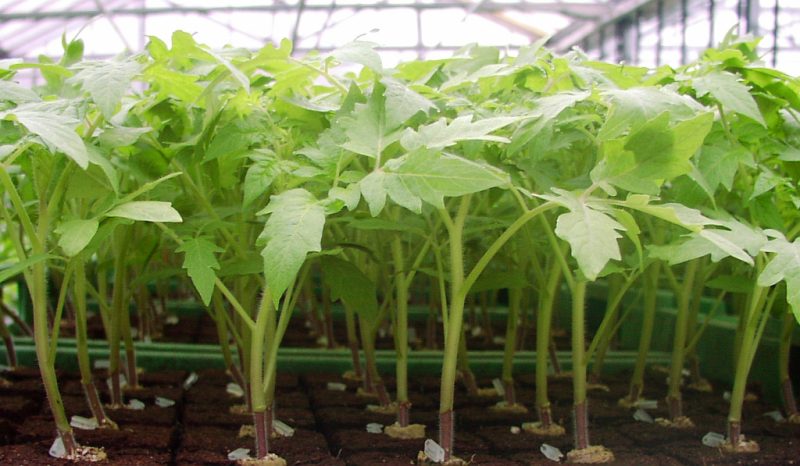
It’s risky to buy seedlings from private traders.If they independently prepared seeds of hybrid tomatoes, then the offspring will be less productive and early compared to the mother plant. There is a great risk of acquiring infected planting material.
It is recommended to purchase seedlings in containers with soil. The age of plants should not exceed 60 days, height - up to 25-30 cm. Although you can plant seedlings with flowers in the ground and get the first fruits early. It is desirable that the stems below were thick, darker in color. The root system must be well developed, without damage.
In appearance, seedlings determine whether the plants are sick or healthy. Signs of disease are spotty, deformed leaves, shoots. It is not to be hoped that after planting it will be possible to quickly correct defects by spraying with pesticides.
Soil preparation
Tomatoes prefer open, well-lit areas, fresh fertile soils. Tomatoes grow poorly in lowlands or in elevated places, blown by the winds. In a crop rotation, tomatoes are best grown after peas and other legumes. Good predecessors of root crops: beets, carrots. Are not suitable areas where in the previous season grown potatoes, eggplant.
The site is prepared in advance: they dig it up, level it with a rake. Poor soils need the addition of peat, humus, wood ash. You can pour humus directly into the hole during planting.
Planting seedlings in open ground
The second decade of May is best suited for planting tomatoes. It is important that the threat of late spring frosts is over. If the weather is cloudy, then you can plant tomatoes in the open in the morning. On a sunny day, it is better to transfer this work to the evening.
Plants are placed in the hole at a slight angle or vertically. The first method is more suitable for high seedlings. The root lump or peat pot is completely buried in the soil. The earth around the seedlings is pressed with their hand to the roots. Then watered and sprinkled with humus. After two weeks, they lower the lower part of the plant to a height of 10–12 cm for better formation of adventitious roots.
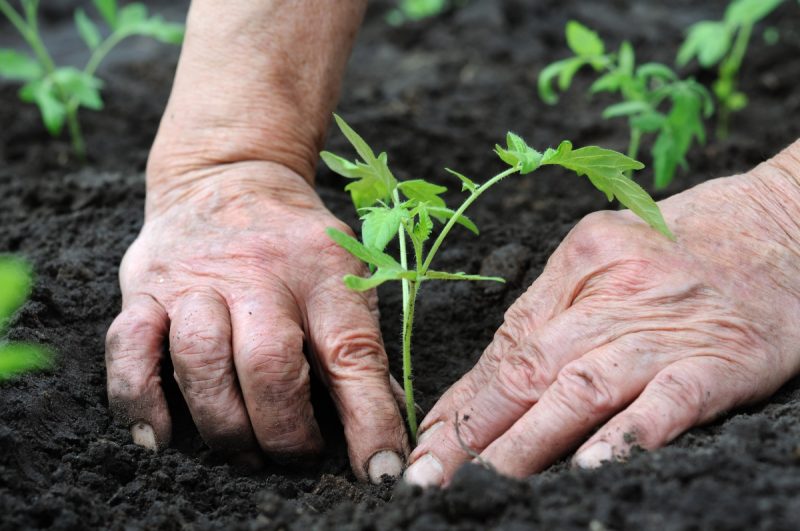
It is important to consider the possibility of mulching after each watering. This contributes to the growth of additional roots in the surface layer, protects against moisture loss.
One and two-line plantings of tomatoes are practiced, on ridges and without them. For low-growing varieties and hybrids, the distance between the plants in the row is 40 cm, the row-spacing is from 40 to 50 cm. Tomatoes with medium height are placed 40–45 cm from each other. Aisles leave 50 cm.
Tomato Care
Tomato roots take root within 7–10 days after planting in open ground. If frost is expected, then seedlings are covered with a film or cut plastic bottles at night. Tomato care also consists of watering and feeding, removing weeds, loosening row-spacing and pinching.
Watering, fertilizing and fertilizing
In the heat, the tomatoes are watered with warm, settled water once every three days. Reduce the amount of irrigation in cloudy and rainy weather. After watering, the bed must be mulched with compost or peat to a height of about 2 cm. It is recommended to water the tomatoes in the evening to avoid the formation of crust on the soil, but it is better to do this early in the morning to protect the plant from fungal diseases.
The first time the root dressing is carried out 20 days after transplanting. Use universal liquid fertilizer and nitrofoska granules: add 1 tbsp. l on a bucket of water. The second time they feed tomatoes after blooming a flower brush. Pour under each plant 1 liter of a solution of the same composition that was used for the first feeding.
The third time fertilize tomatoes in which the third flower brush has blossomed. The fourth feeding of tomatoes - after 2 weeks. A solution of liquid universal fertilizer is used. You can feed urea and nitrophos in July (1 and 2 tbsp. L.for 10 liters of water).
How to shape and pinch tomatoes?
You can leave one stalk, remove all side shoots. This technique is called pinching. On the main shoot there should be 5 or 6 flower brushes.
How to pinch tomatoes in open ground: a few leaves are left above the upper brush and pinch the top. Or leave the lower stepson, but then the number of flower brushes on the main shoot should be reduced to four, and on the stepson - to three.
How to tie tomatoes in the open ground?
Near each plant, which they plan to later tie up, a peg is installed, or strong stakes are instilled at the edges of the row and a wire or cord is pulled between them. As a material for garter use twine, thick synthetic threads that do not rot. Pegs can be wooden or metal.
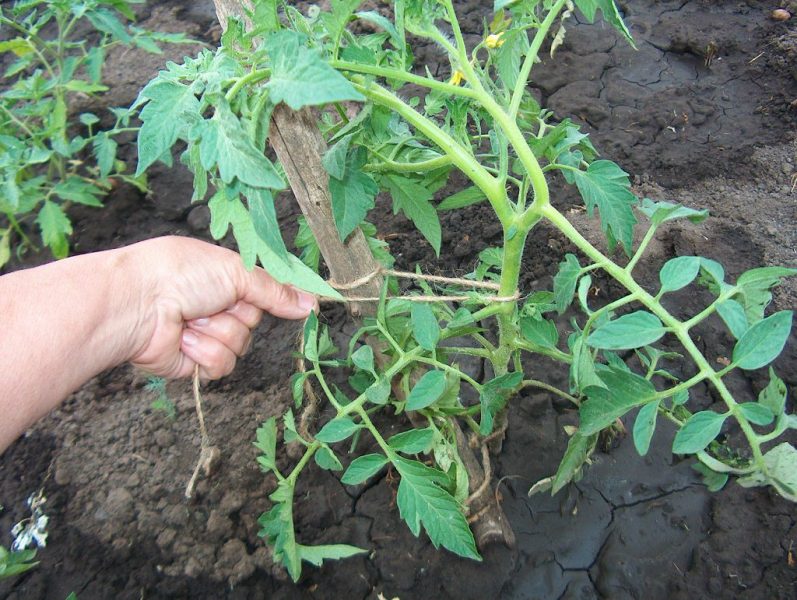
Tie the tomatoes to the wire or peg is not too tight, making the so-called "eight" from the twine in front of the stem (they are intertwined). There are other options for strengthening the stems: a cap made of twigs, a grill and a mesh.
The main problems associated with growing
Tomatoes are very susceptible to low temperatures, poorly tolerate excessive moisture and lack of light. Even the best regionalized varieties weakly resist adverse environmental factors if they do not receive proper care.

In conditions of lack of water, the leaves turn yellow and dry, the fruits remain small, stiff. Excess moisture is also harmful: the roots rot, the fruits crack. Bushes overfertilized with fertilizers increase the vegetative mass to the detriment of fruit setting. Leaves and fruits on a hot afternoon can get sunburn, which looks like whitish spots.
Diseases and pests of tomatoes
Fungal, bacterial and viral diseases are dangerous for tomatoes. To combat the first group of pathogens, a tomato is treated once a decade from phytophthora and fusarium wilting with Bordeaux fluid. You can use strong fungicidal agents 2 times per season.
Tomatoes affected by bacterial infections are treated with solutions of Bactofit or Fitosporin preparations. The second remedy is also used against fungus. Biological products are less dangerous for humans, they are used for spraying up to harvest.
The most effective method of combating tomato viral diseases is the cultivation of resistant varieties and hybrids. Be sure to disinfect the seeds before sowing a solution of potassium permanganate (if you can purchase this antiseptic in a pharmacy).
Dangerous pests of tomatoes are the bear, wireworm, Colorado potato beetle, nematodes. Caterpillars of the butterfly scoop are capable of destroying the crop by eating the fruits from the inside. Control measures, the means used are the same as on other nightshade crops.
Harvesting and storage
In July, August, September, ripe fruits are harvested for fresh consumption and canning. After lowering the night temperatures, you can pick up green tomatoes and store at a temperature of up to 18 ° C for ripening. Brown fruits reach the ripeness faster, upon which light enters.
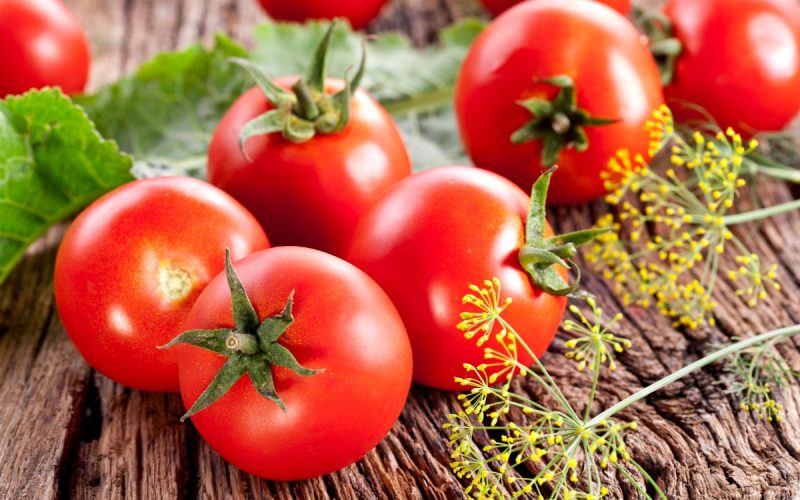
Stack the tomatoes for ripening in flat boxes in one or two layers. The stems are removed, but so as not to damage the skin and pulp. A few red ones are added to green and brown tomatoes to accelerate ripening. Store ripe fruits in a cool, dry place, but not in the refrigerator.












